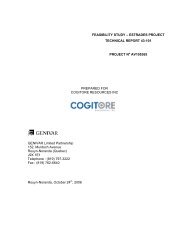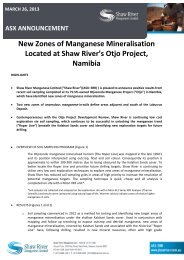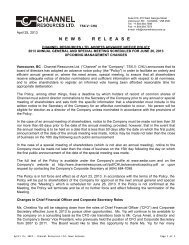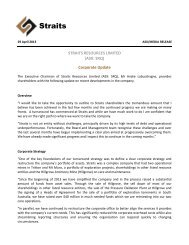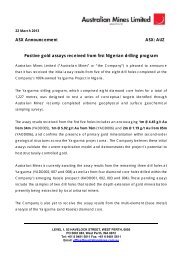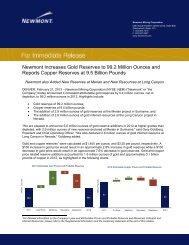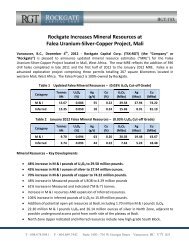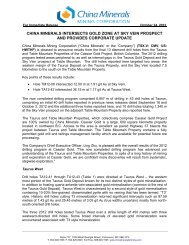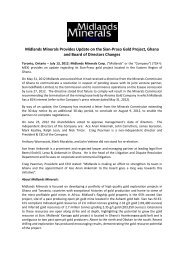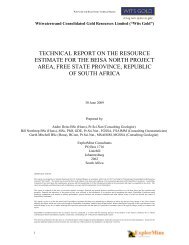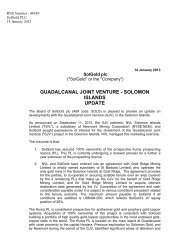Wells Caldwell Fournier _2_ - InfoMine
Wells Caldwell Fournier _2_ - InfoMine
Wells Caldwell Fournier _2_ - InfoMine
You also want an ePaper? Increase the reach of your titles
YUMPU automatically turns print PDFs into web optimized ePapers that Google loves.
SUNCOR POND 5 COKE CAP<br />
THE STORY OF ITS CONCEPTION, TESTING, AND ADVANCE<br />
TO FULL-SCALE CONSTRUCITON<br />
Patrick Sean <strong>Wells</strong>, Suncor Energy Inc., Fort McMurray, AB<br />
Jack <strong>Caldwell</strong>, Robertson GeoConsultants, Vancouver, BC 1<br />
Joseph <strong>Fournier</strong>, Suncor Energy Inc., Fort McMurray, AB<br />
Abstract<br />
The Pond 5 Tailings Impoundment at the Suncor Energy Oil Sands Mine north of Fort McMurray,<br />
Alberta, was turned over to the mine’s reclamation department in 2009 for closure. At the<br />
beginning of 2010, construction of a pond-wide coke cap, part of the proposed final cover, was<br />
begun. In the two years preceding construction of the pond-wide coke cap, the authors<br />
undertook extensive laboratory and field trials of a prototype coke cap.<br />
This paper describes the theoretical and practical work done to formulate a viable and safe coke<br />
cap—in effect the cap that is now under construction across almost the entire pond.<br />
We describe field testing to characterize the tailings; laboratory testing undertaken to characterize<br />
the response of the tailings to planned construction procedure; and two prototype covers<br />
constructed in the winters of 2008 and early 2009 to test and confirm theoretical analyses and<br />
designs.<br />
1 Introduction<br />
Suncor Energy, Inc. plans to close the Pond 5 tailings impoundment at the Suncor oil sands mine<br />
north of Fort McMurray by 2019. This paper describes the design and construction between 2008<br />
and 2010 of a coke cap over the soft tailings; the coke cap will serve as the basal layer of the<br />
planned final cover that will include a thick sand layer, soil, vegetation, drainage swales, and a<br />
lake. In addition, the coke cap provides access to the surface of the tailings for equipment and<br />
1 Robertson Geoconsultants, Suite 900, 580 Hornby St, Vancouver, BC V6C 3B6.<br />
604 684 8072
possible installation of wick drains that may be used to promote dewatering and hence<br />
consolidation of the tailings.<br />
2 Description of Pond 5<br />
Pond 5 has been in use since the mid 1950s. It is roughly fan-shaped and extends about 3 km<br />
north south and about 5 kilometers east west (Figure 1.) The west and north perimeter dikes<br />
were constructed of tailings sand to a height of upwards of 100 m to enclose a mined-out open<br />
pit.<br />
Figure 1. Suncor Tailings Ponds<br />
Fort McMurray, Alberta<br />
Pond 5<br />
Pond 1<br />
The tailings vary considerably. The upper layer is very soft, low strengths (less than 1 kPa)<br />
clayey materials that are still essentially fluid at void ratios of up to five. The strength and sand<br />
content increase with depth to the bottom of the pond that is deeper than 50 m. (Figures 2 and 3.)
Figure 2. 2009 Pond 5 Solids Section B<br />
1100.3’<br />
50-60% 60-70%<br />
70-75%<br />
>75%<br />
• 50% solids surface elevation: 1090’<br />
• 75% solids elevation: SE part, 1074’; NW part, 1054’<br />
there is a large volume of coke available at site and the coke is essentially a waste product. The<br />
coke is light and floats on the fluid tailings.<br />
Figure 4. 2008 & 2009 Access<br />
Road Section<br />
On the basis of successful covering of uranium mill tailings at Wismut, we decided to construct a<br />
prototype cover as follows (Figure 4):<br />
• Pack or remove winter snow to induce freezing of the upper tailings<br />
• Place a geotextile over the frozen tailings which constitutes a safe access surface.<br />
Adjacent rolls of geotextile were overlapped.<br />
• Place a geogrids over the geotextile with the long axis of the geogrids perpendicular to<br />
the long axis of the geotextile roll and parallel to the short access of the section. Adjacent<br />
rolls of geogrid were overlapped.<br />
• Place an initial lift of coke, one-meter thick, using light equipment, primarily SnoCats.<br />
• Place subsequent lifts of coke up to three-meters thick using heavier equipment.<br />
• Along the Access Road thus constructed continue to transport coke using heavy<br />
equipment, including Moxies that weight up to 60 tons fully-loaded.<br />
4 Design Analyses<br />
The concept is simple: the coke floats on the upper tailings (essentially at a factor of safety of<br />
one) and the coke is held “together” by the basal geosynthetics. One almost needs no more than<br />
Archimedes Principle to establish the geometry of the floating mass.
In spite of this simplicity, we undertook extensive FLAC analyses of various sections and differing<br />
equipment loads (Figures 5 and 6.) FLAC is a finite element code that enabled us to replicate<br />
both the fluid and soil-like response of the tailings to the loading of the coke cap and imposed<br />
equipment.<br />
JOB TITLE : Y displacement<br />
FLAC (Version 5.00)<br />
LEGEND<br />
17-Jan-08 16:09<br />
step 20092<br />
-6.667E+00
5 2008 & 2009 Construction<br />
In 2008 we constructed a series of coke cap access roads out over beach materials at the south<br />
west corner of the pond (Figure 7.) In 2009 we extended a coke cap access road out from the<br />
west dike of the Pond and over deep, soft tailings. On the basis of the success of these<br />
prototypes, a decision was take to proceed to full-scale construction in the winter of 2010.<br />
Figure 7. 2010 Design Overview<br />
• Construct a network of<br />
floating roads across the<br />
pond<br />
– Maximize construction in winter<br />
• Infill the internal areas with<br />
conventional approach<br />
– Late summer (desiccation) or winter<br />
• Leads to trapping as<br />
opposed to squeezing the<br />
MFT<br />
6 2010 Construction<br />
To provide for pond-wide coke delivery, it was decided to construct a series of access roads<br />
across the pond (Figure 8). The design of these access roads is essentially as for the access<br />
roads of the 2008 and 2009 road, except that a stronger, seamed geotextile was used.<br />
Because the winter was shorter than usual only eleven kilometers of access road was<br />
constructed. It is planned to construct the remainder in the winter of 2010 and 2011.<br />
Construction proceeded without any incidents.
Figure 8. 2010 Access Road -<br />
Cross Section<br />
• High Strength Woven Geotextile on the tailings<br />
– 100 m wide<br />
– 4.5 m x 100m long panels seamed perpendicular to road alignment<br />
– 82.5 kN/m strength including seams<br />
• Biaxial geogrid on the geotextile (75 m wide)<br />
• 3 m of coke, 30 m wide for Articulated Truck traffic<br />
– Bottom 1 m of coke is 90 m wide. 5 m on each side left for mud wave.<br />
• Drain down the middle of the road with sumps at intersections<br />
Vertically Exaggerated<br />
7 Acknowledgements<br />
We acknowledge Andy Robertson who knew the Wismut covers and had the insight to apply the<br />
ideas to Suncor. He supported and encouraged us through all phases.<br />
Peter Byrne, now a retired UBC professor, and Ernie Naesgaard, and independent consultants<br />
were there to remind us of the basics of fundamental soil mechanics and to undertake the FLAC<br />
analyses.<br />
Gordon McKenna of BGC and Richard Dawson and Erin Olsun of Norwest provided invaluable<br />
peer review and new ideas through all phases of work.<br />
AMEC and their staff compiled the 2010 detailed designs and oversaw construction. We cannot<br />
note them all, so refer to but two: Gordon Pollack and Ed McRoberts who had the courage to take<br />
our small-scale success and turn them into large-scale successes.<br />
None of this would have happened without the Suncor field staff: Neil Jevning and Ivan Decker<br />
who managed all construction, Joseph <strong>Fournier</strong> who looked after things from his office
overlooking the pond, and the managers of the Suncor reclamation group, Bill Tully and Mat Le<br />
Blanc, who had to manage us and the large budgets.



